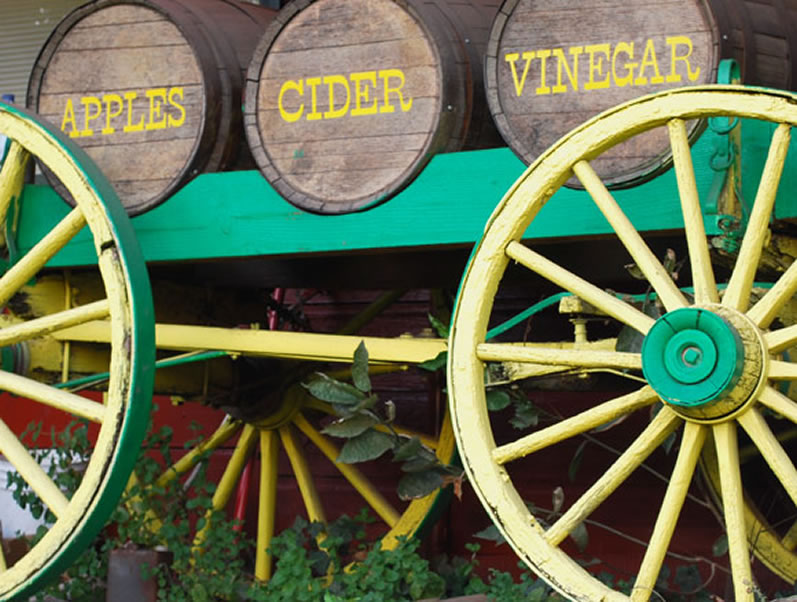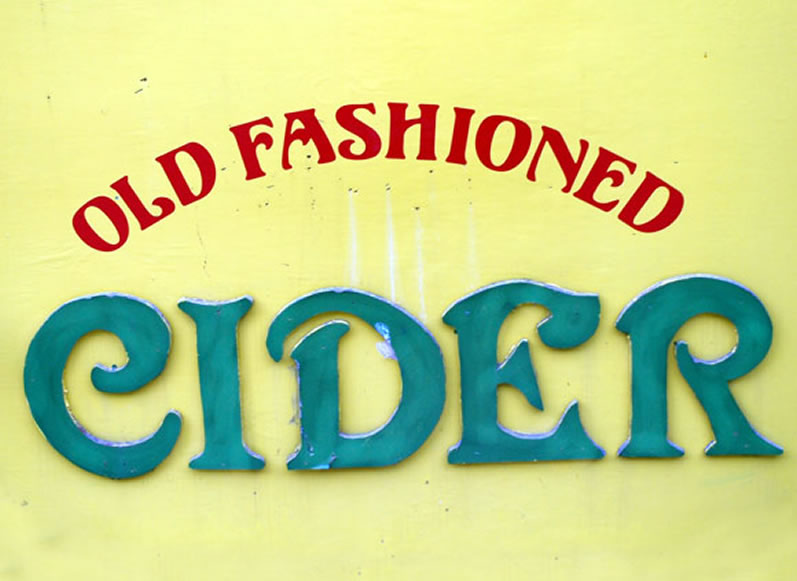
Fresh cider is the natural, sweet liquid that is released by pressing finely chopped or ground apples. The liquid is fresh cider as long as it remains in its natural state and is not sweetened, preserved, pasteurized, clarified, or otherwise altered. If pasteurized or preserved with additives, the initial sweet cider should technically be called apple juice–although often as not, this distinction is not made in the supermarket. Apple juice tastes absolutely pedestrian compared to apple cider. All the life, subtlety, and nuance is “cooked” out of it. Fresh cider is always sweet, full of apple flavor, and is not effervescent.
Fresh cider is highly volatile and alive, and must be kept under refrigeration to slow and control the hardening process. Wild yeasts present on the skin of the apples inoculate the juice as it is being pressed and begin almost immediately to change the natural sugars in the juice to alcohol. As fermentation converts the sugar to alcohol and the solid particles slowly settle, the sweetness begins to subside, and the cider appears clearer and lighter in color. The end result is called hard cider and is really the same thing as apple wine.
Bottled cider is a clear and usually straw-colored liquid that is effervescent and often fruity in taste. An alcohol content of 3-6% is the norm. The style and taste varies greatly from maker to maker. Some ciders are left on the dry side while others are left with some residual sugar or given a dose of sugar just before bottling. And then of course different apples are used with different brands, accounting for even more potential variance.
Sampling American, European, Canadian, and Australian ciders can be great fun. Remember, because of the alcoholic content, these are available in wine and liquor stores only in the Northwest. Use the same type of tasting procedures and terminology that you would for wine. Fruitiness, balance, body, acidity, and sweetness are terms that all apply to cider. In some English bottled ciders, tannin is also present.
Selection
Fresh cider is generally a local commodity. In Washington, there are several small commercial producers. Their ciders can be found at the Pike Place Market, in health food stores, and at roadside stands. Since each producer uses a different blend of apples and more or less quality control, each makes a different tasting cider. Be sure what you are buying is very fresh. I have never tasted a bad apple cider.
Season
Fresh cider is usually best in the fall when apples are at their premium, but there are producers that have the capacity to freeze the fresh crushed apple pomace, thus enabling them to make cider year-round from premium-tasting apples.
Storage
Fresh cider will remain in its sweet full-bodied condition for 10-21 days if stored at or below 38 degrees–in other words, if refrigerated. (Cider may also be frozen to preserve it for longer periods of time.) The cool temperature slows but does not stop the natural fermentation process. After this process begins, cider becomes a successive number of different beverages.
Hardening
Hardening–turning sugar to alcohol–is best done with as little exposure to air as possible, in the lower temperature ranges for optimum flavor. (The cap on a bottle of cider should be just a little loose to allow for escape of carbon dioxide, but not so loose as to allow oxygen to enter the bottle.) Rough, strong tastes occur when temperatures higher than 40º Fahrenheit are used. Successful fermentation is not a guarantee regardless, but carefully made cider rarely goes bad if proper precautions are taken.
The first stage of natural fermentation is the semi-dry stage. At this point the cider is usually quite effervescent and noticeably drier than when first pressed. The alcohol content is usually no more than 3%. Semi-dry cider is fruity and still fairly sweet. Most bottled ciders fall into the semi-dry category.
The second stage is designated as dry-hard. This stage often takes weeks at low temperature to achieve. Dry-hard cider is bone dry and 6-7% alcohol. Dry-hard cider is quite clear and if stored for weeks after fermentation is complete, will become totally clear as suspended particles sink to the bottom of the jug. Some fruitiness may be in evidence at this stage but most dry-hard ciders have virtually no apple flavor. Effervescence also disappears when full fermentation is finally reached.
If apple cider vinegar is desired, remove the cap from the bottle and expose the fermenting cider to the air. This change from alcohol to acetic acid can take several weeks and for best flavor should also be completed below 40 degrees.
Cooking
Sweetness is a primary consideration when using cider in cooking. The natural sugar in fresh sweet cider averages 12%, which translates to 2 tablespoons sugar per cup of liquid. If less sweetness is desired, use semi-dry or dry-hard cider.
Balance in the cider between sweetness and acidity are also important to the cook. Most well-made cider is high in acid. This acid can be desirable in many dishes.
Fruitiness is a consideration also. The cook needs to determine whether a definite apple taste is desirable in a particular dish. If it is, use fresh sweet cider or semi-dry cider, if not, use dry-hard cider.
Great Partners
Almond, anise, Applejack, apricot, Armagnac, bacon, blue cheese, brandy, brown sugar, burnt sugar, butter, Calvados, Camembert, caramel, cardamom, carrot, cauliflower, celery, cheddar, chicken, cider, cinnamon, coffee, cognac, coriander, corn, cloves, cranberry, creme fraîche, cream, currants, eggs (custard), fish (mild, white), ginger, ginger root, hazelnut, Grand Marnier, honey, maple syrup, melon, molasses, lemon, lettuce, lime, mascarpone, nutmeg, oatmeal, orange, pear, pepper, pork, praline, prune, radish, rhubarb, rosemary, sausage, sour cream, vanilla, walnut, yogurt.
Additional Pairings
LunaCafe Recipes
- Spiced Apple Cider Caramel Sauce
- Mulled Apple Cider with Warm Winter Spices, Cayenne & Hibiscus
- Sauté Of Chicken With Caramelized Apples & Toasted Hazelnuts
- Hazelnut Honey Toffee Tart with Cranberry Variation
- Hazelnut-Fried Fresh Mozzarella With Apple Cider, Granny Smith Apples & Chives (PNP)
NOTE PNP = Pacific Northwest Palate: Four Seasons of Great Cooking
Resources
- Apple Country Heritage Cider
- Apple History and Legends
- BelleWood Acres
- Cider Making in North America
- Heirloom Apples
- Kiyokawa Family Orchards (varieties list)
- Making Apple Cider
- Minea Apple Cider
- Orange Pippin
- Oregon Farmers Markets Association
- Puget Sound Apple Farms
- U.S. Apple Association Apple Guide
- Washington Apple Country
- Washington Apple Country Tours
- Washington Apple Varieties
- Washington State University
…

